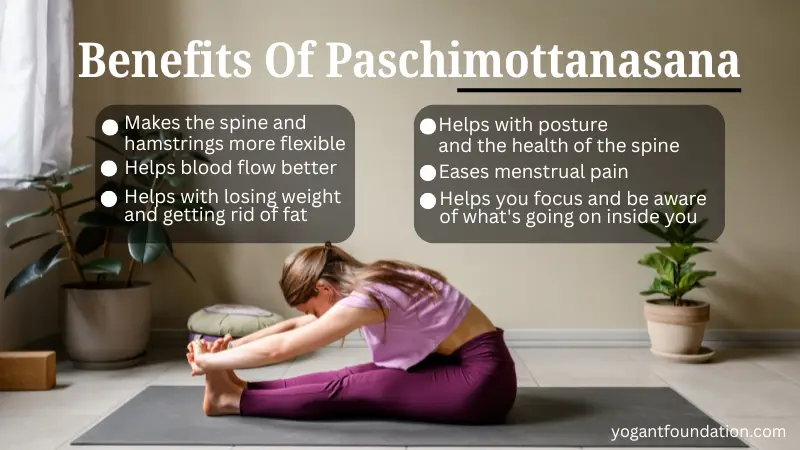A Brief Overview
Paschimottanasana Let’s explore the meaning, technique, and safety tips for Paschimottanasana. We will also discuss the top 10-benefits of Paschimottanasana .
Paschimottan asana, is one of the most important poses in Hatha Yoga. The word “Paschima” in Sanskrit means “west,” which is the back side of the body. “Uttana” means “intense stretch,” and “asana” means “pose.” Paschimottanasana not only makes you more flexible, but it also helps you relax and feel better overall.
This pose may change your yoga practice, whether you’re a novice or a pro. Let’s explore the meaning, technique, and safety tips for Paschimottanasana. We will also discuss the top 10 benefits of this pose.
A Step-by-Step Guide to Doing Paschimottanasana Right
Here’s a step-by-step, the right way before we talk about the benefits:
1. Sit on the floor with your legs straight out in front of you.
2. Keep your shoulders relaxed and your spine straight.
3. Take a deep breath, raise your arms above your head, and stretch.
4. As you lean forward from the hips (not the waist), breathe out softly.
5. If you can, reach for your toes, ankles, or shins.
6. Try to move your chest toward your thighs and your forehead toward your knees.
7. Breathe deeply and hold the stance for 30 seconds to 2 minutes.
8. Let go slowly by breathing in and bringing your torso back up.
10-Health Benefits of Paschimottanasana
1. Makes the spine and hamstrings more flexible
Paschimottanasana stretches the whole back of the body, including the spine, hamstrings, and calves, very deeply. The benefits of Paschimottanasana extend far beyond flexibility. It helps to relieve muscle tension and make you more flexible if you do it regularly. This stance is great for athletes, dancers, and anyone who has to sit for a long time.
2. Gets the digestive organs going
This pose that bends forward gently squeezes the stomach, liver, pancreas, and kidneys, which makes them work better. It can help with digestion, speed up metabolism, and even cure minor constipation as a result.
3. Soothes the nervous system and lowers stress
Paschimottan asana activates the parasympathetic nervous system by encouraging calm, deep breathing and focusing inward. Helps clear your head, calm your thinking, and lower your anxiousness. People often utilize it in yoga to help them deal with stress and anxiety.
4. Helps blood flow better
When you bend forward, more blood flows to the brain. It may aid with memory, focus, and other cognitive skills. At the same time, the stretch along the spine helps blood flow to the back muscles and internal organs.
5. Helps with losing weight and getting rid of fat
Paschimottan asana works the core muscles, massages the organs inside, and speeds up the metabolism. With daily use, it helps burn fat around the thighs and stomach. When done with other yoga poses and a healthy diet, it can help you lose weight.
6. Helps with posture and the health of the spine
Long hours on screens or bad seating might hurt your posture. Paschimottanasana can help straighten out the spine, make the back muscles stronger, and ease long-term back pain. It helps persons who have slouched or curved posture the most.
7. Helps you focus and be aware of what’s going on inside you
People generally do this pose in silence, which helps you explore inside yourself. The forward fold makes you feel like you’re giving up, anchoring you, and separating your mind from outside distractions. It helps you focus and is great for students or people who work.
8. Eases menstrual pain
Help with cramping during your period, balance your hormones, and make you less bloated. This pose helps ease PMS and menstrual cramps by relaxing the lower belly and pelvic area.
9. Can help with mild depression and tiredness
This pose is a gentle inversion that calms the brain. It releases endorphins, which can aid with anger, weariness, and feeling down. People who are suffering from burnout or emotional weariness can benefit from regular practice.
10. Awakens Kundalini Energy and balances the chakras
In traditional yoga, practitioners believe that the benefits of Paschimottanasana activates the Manipura Chakra (solar plexus), which controls willpower and change. It also gets the body ready for deeper pranayama and meditation, which are important for Kundalini awakening.
Warnings and Precautions
Paschimottan asana is safe for most people, but there are several things you should keep in mind:
Don’t do this position if you have bad back pain, sciatica, or a slipped disc.
Paschimottanasana is usually safe, although some people should be careful or not do it at all:
If you have significant lower back discomfort, sciatica, or a herniated disc, you should see a doctor before doing this pose.
People who are pregnant should stay away from deep forward bends, especially in the second and third trimesters.
People who have asthma or diarrhea may not like this stance and should not do it.
Never push yourself to stretch or strain your back. Always listen to your body.
People with asthma or diarrhea shouldn’t do this pose. Always pay attention to your body’s boundaries and never push it.
Changes for Beginners
Here are some changes you can make if you’re new to yoga or aren’t very flexible:
Wrap a yoga strap over your feet and pull yourself forward gently.
- Sit on a folded blanket to raise your hips.
- Bend your knees a little to ease the strain on your lower back.
- Get alignment tips from a trained yoga teacher while you practice
- When and How Often to Do Paschimottan asana:
- Best done on an empty stomach, preferably in the morning
- Hold for 30 seconds to 2 minutes, depending on how comfortable you are
- Do it 3–5 times a week for the best results
- Use with counter postures like Bhujangasana (Cobra Pose) or Purvottanasana (Upward Plank)
Last Thoughts: Enjoy the quietness of the benefits of Paschimottanasana
Paschimottan asana is more than simply a stretch for your body; it’s a way to look inside yourself. This position is good for the whole body and mind, whether you want to be more flexible, less stressed, or have better digestion. It’s a great supplement to your yoga practice and can be done by people of all ages with the right technique.
Take it leisurely, breathe deeply, and appreciate the relaxing energy this pose gives to your life.
Commonly Asked Questions (FAQs)
Q1. What does Paschimottanasana represent in yoga?
In Sanskrit, “Paschimottan-asana” means “Intense Stretch of the West.” It refers to a forward bend that strains the back of the body.
Q2: Can Paschimottanasana help you lose belly fat?
Yes, the benefits of Paschimottanasana, it helps engage core muscles and digestion, which helps reduce belly fat when done regularly.
Q3: How long should I stay in Paschimottanasana?
People who are just starting can start with 20 to 30 seconds and work their way up to 1 to 2 minutes as they become used to it.
Q4. Is Paschimottanasana useful for back pain?
Yes, it can help with mild back pain, but don’t use it if you have herniated discs or sciatica without a doctor’s supervision.




Hey I know this is off topic but I was wondering if you knew of any widgetsI could add to my blog that automatically tweet my newest twitter updates.
I just could not depart your site before suggesting that I really enjoyed the standard information a person provide for your visitors? Is gonna be back often in order to check up on new posts
I’m not sure where you’re getting your info, but great topic. I needs to spend some time learning more or understanding more. Thanks for great info I was looking for this information for my mission.
Thank you for the auspicious writeup. It in fact was a amusement account it. Look advanced to far added agreeable from you! By the way, how could we communicate?
wonderful points altogether, you just received a new reader. What would you suggest about your put up that you simply made some days ago? Any positive?
Hello! I just wanted to ask if you ever have any problems with hackers? My last blog (wordpress) was hacked and I ended up losing months of hard work due to no back up. Do you have any methods to prevent hackers?
I am actually pleased to read this blog posts which contains lots of useful facts, thanks for providing these kinds of information.